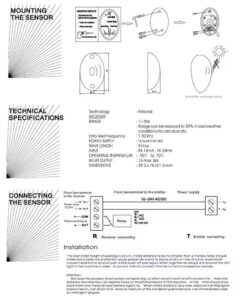Point-to-Point Beams represent a fantastic early warning system, allowing homeowners to quickly ascertain whether or not there is an intruder on the property. They work fairly simply and generally come in two parts – a transmitter and a receiver. The transmitter is mounted on a wall or fence and sends out a pulsed beam of infrared light which is processed by the receiver. If this beam of invisible light is broken by an intruder, an alarm will sound, alerting the homeowner to the presence of any intruders.
Infrared security point-to-point systems, also known as infrared beam systems or IR beam systems, are used to establish a secure communication link between two fixed points. Unlike traditional wireless communication systems, which transmit data through the air using radio waves, infrared point-to-point systems utilize infrared light to transmit data over short to medium distances. Here are some key features and aspects of infrared security point-to-point systems:
1. **Line-of-Sight Communication**: Similar to other point-to-point communication systems, infrared point-to-point systems require a clear line of sight between the transmitter and receiver. Obstructions such as buildings, trees, or other obstacles can disrupt the infrared beam and interfere with communication. Therefore, careful site survey and planning are essential to ensure unobstructed communication paths.
2. **Infrared Transmission**: Infrared point-to-point systems transmit data using infrared light at wavelengths that are invisible to the human eye. The infrared light is modulated to encode digital data, which is then transmitted from the transmitter to the receiver. Infrared communication offers advantages such as immunity to electromagnetic interference and improved security compared to radio frequency (RF) communication.
3. **Security**: Infrared point-to-point systems provide inherent security benefits due to the directional nature of the infrared beam and its limited range. Since the infrared beam is highly directional and does not spread like radio waves, it is less susceptible to eavesdropping or interception by unauthorized parties. Additionally, the short range of infrared communication limits the risk of signal leakage or interception from nearby devices.
4. **Short to Medium Range**: Infrared point-to-point systems are typically used for short to medium-range communication applications, ranging from a few meters to several hundred meters, depending on the specific system and environmental conditions. They are commonly deployed in indoor and outdoor environments for applications such as building-to-building connectivity, wireless networking, surveillance, and industrial automation.
5. **High Data Rates**: Infrared point-to-point systems support high data rates suitable for transmitting digital data, voice, or video signals over short distances. The use of infrared light allows for high-speed communication with low latency and minimal signal degradation, making it suitable for real-time applications such as video surveillance and streaming.
6. **Weather Considerations**: Infrared point-to-point systems are affected by environmental factors such as ambient light, humidity, and temperature. While infrared communication is generally robust in indoor environments, outdoor deployments may require additional considerations to mitigate the effects of sunlight, rain, fog, or dust, which can attenuate or scatter the infrared beam.
7. **Ease of Installation**: Infrared point-to-point systems are relatively easy to install and configure, requiring alignment of the transmitter and receiver units to establish a line-of-sight communication path. Once aligned, the system typically requires minimal maintenance and calibration to maintain reliable operation over time.
8. **Applications**: Infrared point-to-point systems are used in various applications, including wireless networking, inter-building connectivity, remote monitoring, surveillance, perimeter security, and industrial automation. They provide a cost-effective and secure solution for establishing communication links where traditional wired or wireless systems may be impractical or insufficient.
Overall, infrared security point-to-point systems offer a secure, high-speed, and reliable communication solution for short to medium-range applications, providing enhanced security and performance compared to traditional wireless communication technologies. By leveraging the advantages of infrared communication, organizations can address their connectivity needs in diverse environments and applications while ensuring data confidentiality and reliability.
Point to Point Beams
Point to Point Beams
Point to Point Beams
Point to Point Beams
Point to Point Beams
Point to Point Beams
Point to Point Beams






